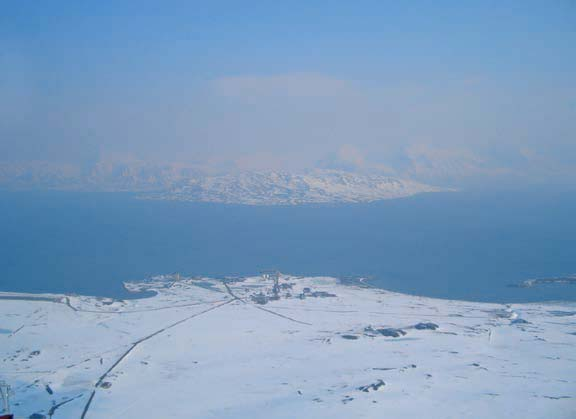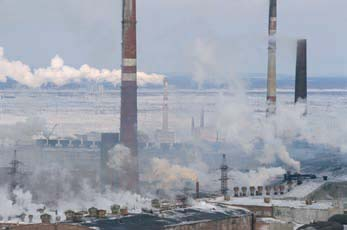ARCTIC HAZE FACT SHEET
"Sometimes back, the skies on a clear day used to be deep blue all over, even at the horizon. Now you can hardly ever see that anymore, especially on the horizon. It is always pale blue, almost white or even dirty gray. It makes me sad to see what future generations are going to have to put up with." -- Matthew Bean, a Yup'ik elder from Betel, Alaska
What Is Arctic Haze?
Arctic haze is a thin, persistent, brown haze that causes limited visibility on the horizons of what had been previously very clear arctic skies. It is most visible in the early spring and can be seen from northern Greenland, the arctic coasts of Canada and Alaska and occasionally in eastern Siberia. It was first noticed in the 1950’s by pilots conducting weather reconnaissance flights in the Canadian high Arctic who began using the term ‘Arctic Haze’ to describe this mysterious smog in such a pristine environment. At this time, it was thought that Arctic haze was a natural phenomenon caused by dust particles blown into the air by wind. The idea that the haze was caused by pollutants from the industrialized South was first put forth in 1972 by Dr. Glenn Shaw of the Geophysical Institute at the University of Alaska.
View from the Zeppelin station at Ny-Ålesund on Svalbard in spring 2006. Particles originating from agricultural fires in Eastern Europe combined with an extreme weather situation that transported the pollution to the Arctic were responsible for this pollution
event. Arctic Monitoring and Assessment Programme, 2006
Arctic haze is made up of a complex mix of microscopic particles and acidifying pollutants such as soot, hydrocarbons, and sulfates. Up to 90% of Arctic haze consists of sulfates. For more information about common air borne pollutants such as sulfates, see the Acid Rain fact sheet.
Often, Arctic haze appears in the form of distinct ‘bands’ or ‘layers’. These bands occur at different heights because warm dirty air is forced upward until it eventually reaches the dome of cold air that sits over the North Pole where it becomes trapped during the winter and is then visible in the spring. This is one reason why Arctic haze can be seen in late winter and early spring rather than either summer or fall. Bands of Arctic haze can be tens of metres thick to a kilometre thick and they can extend from 20km to 200km in distance. Within the bands, visibility can sometimes be as little as a few kilometres because of the way light particles are scattered and absorbed by Arctic haze.
The Arctic haze that accumulates by late winter, trapped under the dome of cold air, is as large as the continent of Africa! As light begins to arrive in the spring, Arctic haze can at times look the same as the haze of smog that hovers over cities like Los Angeles.
What Does Arctic Haze Do?
One important thing that Arctic haze has done and continues to do is draw attention to the fact that pollutants do not obey national boundaries. The Arctic, because of its ecological fragility, is especially susceptible to the effects of industrial pollutants on its environment. Most of the pollutants that end up in the arctic do not originate there but are instead transported north through atmospheric, oceanic and landbased pathways from industrialized areas in the south. For more information about how pollutants are transported to the Arctic, see the Transboundary Pollution fact sheet.
The unique geographical and climate characteristics of the Arctic make it a reservoir for a variety of pollutants from around the globe. In regards to Arctic haze, cold and dry air in the Polar Regions allows pollutants that are transported through atmospheric pathways to remain wind borne for weeks rather than days, as would be the case in a southerly environment. That these pollutants remain wind borne for a longer amount of time means that they can spread further, covering more of the Arctic.
The most obvious and immediate effect of Arctic haze is that it reduces visibility. The particles that make up the haze are, however, much less concentrated than they are in more populated and industrialized areas. The haze itself, largely because of low deposition rates, does not cause adverse effects on plants and animals, nor does it cause direct health problems in humans.
One direct effect that is had by Arctic haze is its ability to warm the Arctic by covering highly reflective snow with acidic and soot-laden aerosols (air borne particles). This means that a person looking out onto the Arctic from space would see an orange-brown North Pole rather than a white North Pole at certain times of the year. This point leads us to the effect of Arctic haze particles after they leave the air and are deposited on the ground. The carbons cause the snow to darken and therefore melt faster while sulfates increase the levels of acidity in the water. Small amounts of toxic metals that traveled north in the haze also end up being deposited into the fragile Arctic ecosystem. For more information on the effects of these pollutants and more, see the Water Pollution fact sheet.
Where Does Arctic Haze Come From?
Higher bands of haze consist of pollutants from warmer areas in the south and form later in the year. Lower bands contain pollutants that come from northerly sources and develop earlier in the year. The following photo is an example of a source of the pollutants that would be found in the lower bands of Arctic haze.
The smelter complex at Norilsk, western Siberia– the largest source of sulfur dioxide emissions within the Arctic region. Arctic Monitoring and Assessment Programme, 2006
We can find out where Arctic haze comes from because the chemicals that make up Arctic haze are like a footprint that can lead us back to their sources. The main sources of the sulfates found in Arctic haze are things like power plants, pulp and paper mills and oil and gas activities. The other pollutants found in Arctic haze can be traced to industries such as vehicles, shipping and agriculture. The places in which these industries occur and where these pollutants thus originate are in the heavily populated and industrialized areas of Europe, North America and Asia. For more information about pollutants that come from oil and gas industry and their effect on the environment, see the Oil Fields fact sheet.
Did you find this information useful? Please help us to send more Operation Water Pollution kits to schools! Please chip in $5 or donate $20 or more and receive an Official Donation Receipt for Income Tax Purposes.
AMAP Popular Reports - “Arctic Pollution 2006”: The third AMAP State of the Arctic
Environment Report.
www.amap.no



